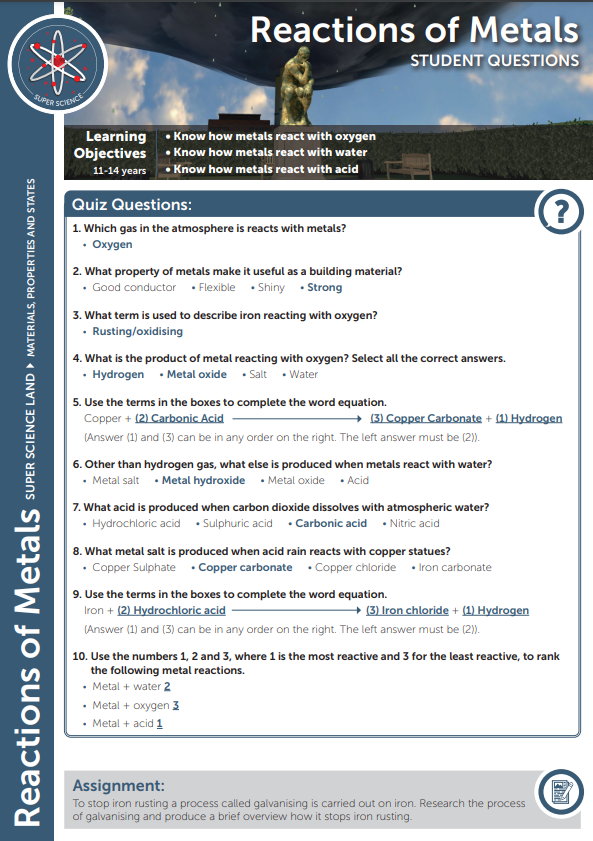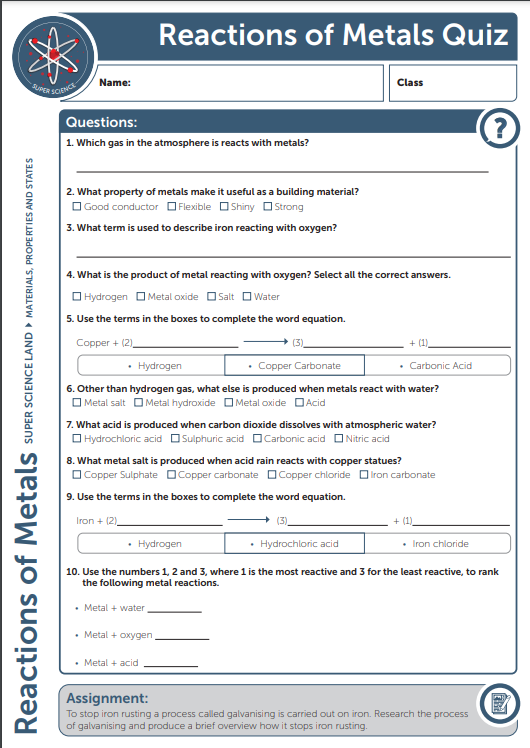 Loading...
Loading...
Initial language selection is based on your web browser preferences.
# Learning objectives 1: Know how Metals React with Oxygen {.info} 2: Know how Metals react with Water {.info} 3: Know how Metals React with Acid {.info} # Metals and Oxygen {.objective .objective1} Students will learn about the effect of oxygen on metals such as iron. They will learn that metals oxidise to produce a metal oxide and hydrogen when metals tarnish. Students will learn to use word equations to describe the reaction of metals with oxygen. Students will be asked to explore the scene and identify metal structures based on their properties. They will be asked to identify any conditions the metals may be exposed to outdoors. # Metals and Water {.objective .objective2} Students will learn about the effect of water on metals such as iron. They will learn that metals react with water to produce a metal hydroxide and hydrogen when metals tarnish. Students will learn to use word equations to describe the reaction of metals with water and that it is faster than reactions with oxygen. Students will be asked to explore and identify metals are exposed to water and look for clues to suggest that water react faster with metals than oxygen. # Metals and Acid {.objective .objective3} Students will learn about the effect of acid on metals such as iron. They will learn that metals react with acid to produce a metal salts and hydrogen when metals tarnish and corrode. Students will be asked to explore the scene and compare the 3 structures tarnishing due to either oxygen, water, or acid. They will be asked to identify which structure tarnishing is caused by oxygen, water or acid based on the speed of the reaction and tarnishing. # Teacher Resources ### Download Teacher Notes [](https://data.avncloud.com/activities/794178/files/Reactions%20of+Metals+Teacher+Notes+1.pdf?date=1677584549&size=926489&md5=0918a720e21bfc7bb1757cb4e4bab890) ### Student Quiz Answers Document [](https://data.avncloud.com/activities/794181/files/Reactions%20of+Metals+Teacher+Notes+2.pdf?date=1677584679&size=523910&md5=cf8ef445d090dde0848642ffbbf7ecb6) ### Download Student Quiz Document [](https://data.avncloud.com/activities/794182/files/Reactions%20of+Metals+Teacher+Notes+3.pdf?date=1677584774&size=95032&md5=9d340ae4c9bcd5ed1a324ff853227465)